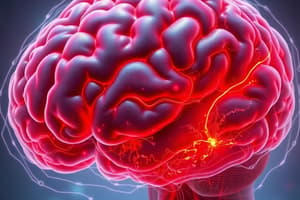Podcast
Questions and Answers
Which of the following are types of edema? (Select all that apply)
Which of the following are types of edema? (Select all that apply)
- Peripheral/Lymphedema (correct)
- Pulmonary (correct)
- Pedal (correct)
- Cerebral (correct)
What is pedal edema?
What is pedal edema?
Effects the lower legs, ankles, and feet, caused by an increase in hydrostatic pressure.
What is pulmonary edema?
What is pulmonary edema?
Fluid in the lungs.
What are the signs and symptoms of pulmonary edema?
What are the signs and symptoms of pulmonary edema?
What is the main cause of pulmonary edema?
What is the main cause of pulmonary edema?
What is peripheral edema?
What is peripheral edema?
What causes peripheral edema?
What causes peripheral edema?
What is cerebral edema?
What is cerebral edema?
What causes cerebral edema?
What causes cerebral edema?
Flashcards are hidden until you start studying
Study Notes
Types of Edema
- Four main types: pedal, pulmonary, peripheral/lymphedema, and cerebral.
Pedal Edema
- Affects lower legs, ankles, and feet.
- Results from increased hydrostatic pressure.
- Common in conditions such as pregnancy and old age.
Pulmonary Edema
- Characterized by fluid accumulation in the lungs.
Pulmonary Edema Signs and Symptoms
- Severe dyspnea (difficulty breathing) and air hunger.
- Cough produces frothy, blood-tinged sputum.
- Symptoms include tachypnea (rapid breathing) and tachycardia (rapid heart rate).
- Skin may appear cold, clammy, with possible cyanosis (bluish discoloration).
- Often accompanied by extreme apprehension, confusion, or stupor.
Pulmonary Edema Causes
- Decreased plasma oncotic pressure due to low albumin levels and malnutrition.
- May occur with right-sided heart failure (RSHF).
Peripheral Edema
- Describes swelling in tissues, often in lower limbs and arms, caused by fluid accumulation.
Peripheral Edema Causes
- Often linked to lymphatic obstruction due to issues with lymph nodes, kidneys, or cancers.
Cerebral Edema
- Refers to swelling in the brain.
Cerebral Edema Causes
- Commonly results from increased capillary membrane permeability due to damaged tissues.
Studying That Suits You
Use AI to generate personalized quizzes and flashcards to suit your learning preferences.



